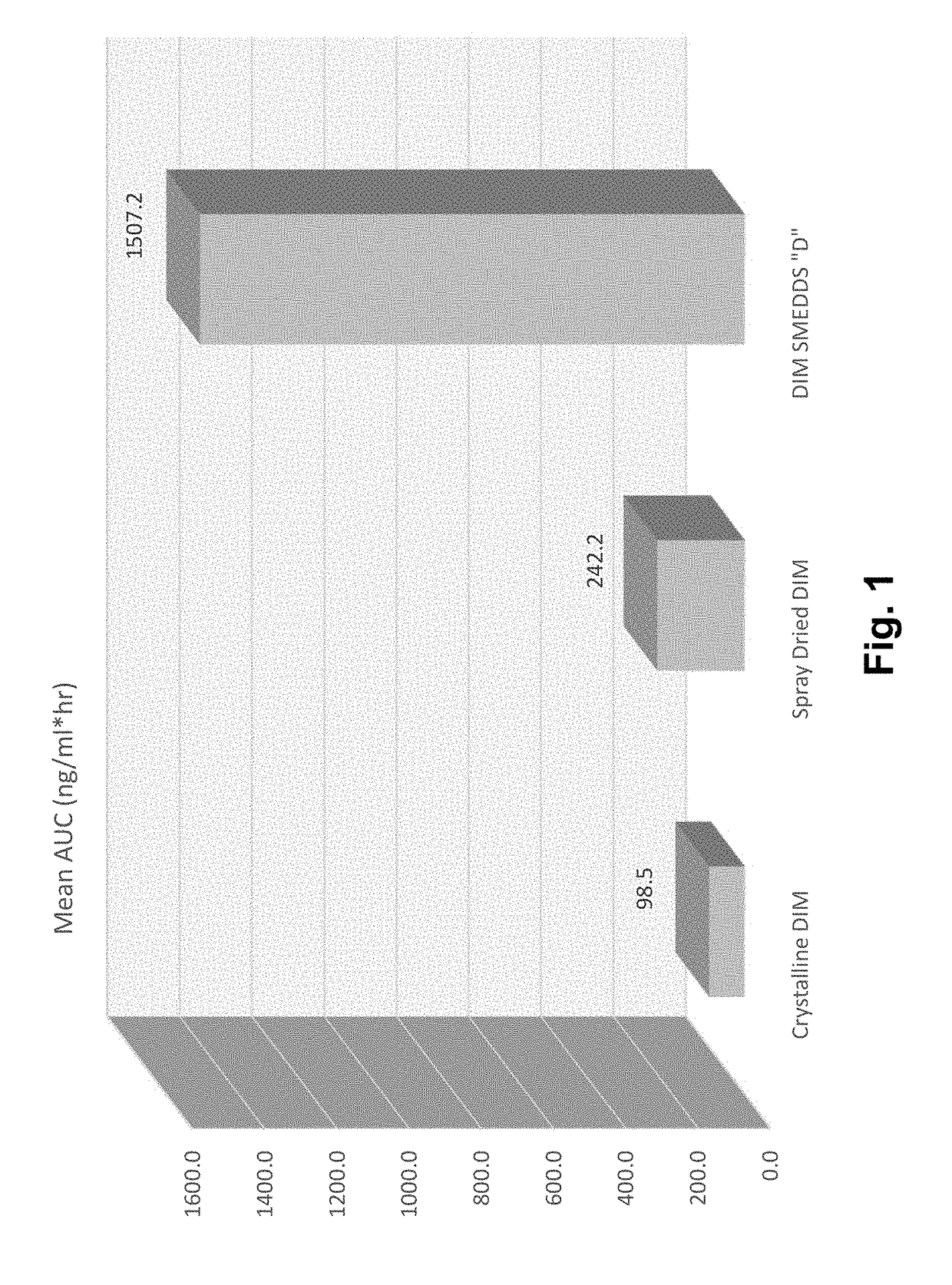Self-emulsifying formulations of DIM-related indoles
a technology of diindolylmethane and composition, which is applied in the direction of nitrile/isonitrile active ingredients, heterocyclic compound active ingredients, capsule delivery, etc., can solve the problems of complex smedds formulation development process, poor oral bioavailability of diindolylmethane (dim), and persistence of highly insoluble and poorly bioavailable dim, etc., to achieve good tolerance, increase the oral bioavailability and shelf stability
- Summary
- Abstract
- Description
- Claims
- Application Information
AI Technical Summary
Benefits of technology
Problems solved by technology
Method used
Image
Examples
example 1
6.1 Example 1
Determination of Physicochemical Characteristics of DIM and Related Multimeric Indole Compounds
[0300]This example describes assessment of the relevant physicochemical characteristics of DIM and structurally related multimeric indole compounds.
[0301]DIM has demonstrated the characteristics of stability in neutral and acidic media. When tested in water DIM demonstrated a maximal solubility of 0.7 μg / ml. When tested in an aqueous acid environment of pH 2, which is similar to the human gastric environment, the solubility was essentially unchanged with a maximal solubility of 0.6 μg / ml. In directly determining the solubility of DIM the shake-flask method for determination of maximum solubility in aqueous media was utilized. The solubility was determined as described by Lindenberg et al., 2004, EurJ Pharm Biopharm. 58(2):265-78. The drug was weighed in excess of its expected solubility in Uniprep® vials equipped with a 0.45-μm membrane filter, and 2 ml of Milli-Q water, 0.01N...
example 2
6.2 Example 2
Evaluation and Ranking of Excipients for Development of a SMEDDS System for DIM and DIM-related Compounds
[0309]The present invention is the result of the determination of unique combinations of excipients that dissolve crystalline Diindolylmethane (DIM) (and are expected to dissolve structurally related multimeric indole compounds) to form pre-concentrates. Upon ingestion, the performance of these SMEDDS formulations results in increased oral bioavailability of DIM compared to crystalline DIM as well as increased bioavailability compared to spray dried formulations where DIM is complexed with tocopherol PEG 1000 succinate (TPGS).
[0310]The first step in this development process was the testing of a variety of excipients chosen as potentially active in solubilizing DIM. Table 1 shows some of the results of this study. The method involved weighing of approximately 2 grams of each of the liquid excipients into a small vial. Subsequently, a small amount of DIM was added and ...
example 3
6.3 Example 3
Formulations of Candidate Mixtures of Oil Solvents, Surfactants, Co-Surfactants, and Additional Components
[0314]Using the information described in Example 2, various DIM formulations were prepared, some of which are described herein. The description of certain formulations in Table 2, below, indicates the weight of each component in the formulation in grams with a total of 10 grams per formulation placed in small vials. The dispersions of such formulations were tested for particle size by laser diffraction following dispersion and spontaneous emulsion formation in water.
[0315]Each of the formulations were tested by dispersing approximately 1 gram of the candidate formulation in 200 mL of deionized water at approximately 37° C. with slow stirring of a magnetic spin bar in a 1 L beaker. Within five minutes of the addition, sufficient mixture was added to a Malvern Mastersizer dynamic laser light scattering instrument to satisfy the obscuration of the laser beams needed fo...
PUM
| Property | Measurement | Unit |
|---|---|---|
| molecular mass | aaaaa | aaaaa |
| size | aaaaa | aaaaa |
| size | aaaaa | aaaaa |
Abstract
Description
Claims
Application Information
 Login to View More
Login to View More - R&D
- Intellectual Property
- Life Sciences
- Materials
- Tech Scout
- Unparalleled Data Quality
- Higher Quality Content
- 60% Fewer Hallucinations
Browse by: Latest US Patents, China's latest patents, Technical Efficacy Thesaurus, Application Domain, Technology Topic, Popular Technical Reports.
© 2025 PatSnap. All rights reserved.Legal|Privacy policy|Modern Slavery Act Transparency Statement|Sitemap|About US| Contact US: help@patsnap.com



